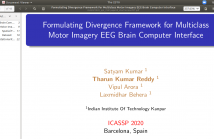
- Read more about FORMULATING DIVERGENCE FRAMEWORK FOR MULTICLASS MOTOR IMAGERY EEG BRAIN COMPUTER INTERFACE
- Log in to post comments
The ubiquitous presence of non-stationarities in the EEG signals significantly perturb the feature distribution thus deteriorating the performance of Brain Computer Interface. In this work, a novel method is proposed based on Joint Approximate Diagonalization (JAD) to optimize stationarity for multiclass motor imagery Brain Computer Interface (BCI) in an information theoretic framework. Specifically, in the proposed method, we estimate the subspace which optimizes the discriminability between the classes and simultaneously preserve stationarity within the motor imagery classes.
- Categories:
 32 Views
32 Views
- Read more about A PRAGMATIC AUTHENTICATION SYSTEM USING ELECTROENCEPHALOGRAPHY SIGNALS
- Log in to post comments
EEG-based authentication is an emerging research field. In this work, a realistic authentication system using Electroencephalography signals, was developed aiming to show that brain signals contain sufficient information to be used in security systems. The dataset used was composed of 29 users on 4 different days via the cheap Neurosky Mindwave headset with a single dry electrode, and 10 users on 3 different days via Emotiv with 14 electrodes. Various techniques, features, and algorithms were examined to achieve the highest security.
- Categories:
 38 Views
38 Views